- The grey headed swamphen is endemic to the South Asian region but they have become common in America too. Juveniles are duller than adults and lack the red bill and shield. They usually inhabitant, in small groups, marshy areas and fresh water bodies such as swamps, rivers, and lakes. They clumsily feed on reeds and floating vegetation at muddy water edges.
- A young swamphen was brought to the centre from Jigni, on the outskirts of Bangalore. He was being kept as a pet captivity. Now he is active and healthy but will not be released soon as he is very comfortable with humans. This would pose a threat to his survival in the wild. BRC is in the process of rehabilitating and rewilding him. Once this happens, he will be released near a protected water body.
You buy Only Earth for the first time and we plant a tree on your behalf.
We are committed to planting 100,000 Mangrove trees in the span of five years. Mangroves plants are highly productive and it is estimated that the average annual carbon sequestration rate of mangrove ecosystems averages between 6 and 8 Mg CO2 e/ha (tons of CO2 equivalent per hectare).
WILDLIFE PROTECTION
-
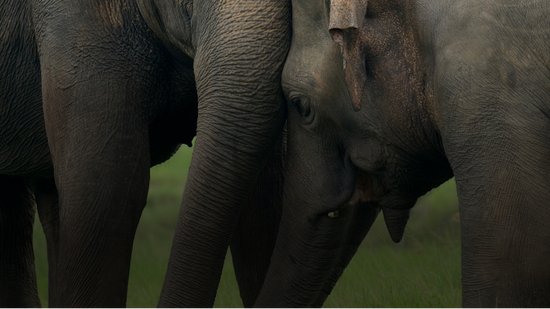
Intro to Partner
Intro to Partner
The Wildlife Rescue & Rehabilitation Centre (WRRC)
was registered in July 1999 as a public charitable trust for the conservation
and welfare of wildlife in urban and rural areas around Bangalore, India. WRRC
was set up by the trustees of Compassion Unlimited Plus Action (CUPA), in
response to a keenly felt need: to provide relief to wild animals, birds and
reptiles; including medical treatment and housing; as well as to handle cases
of cruelty involving these animals.WRRC operate two facilities – the Bannerghatta
Rehabilitation Centre (BRC) and Elephant Care Facility (ECF) in Lakshmisagar,
Karnataka. Besides wildlife rescue and rehabilitation WRRC is also involved in
the prevention of cruelty, humane education, campaigns and legal battles, research
and surveys on captive elephants. -
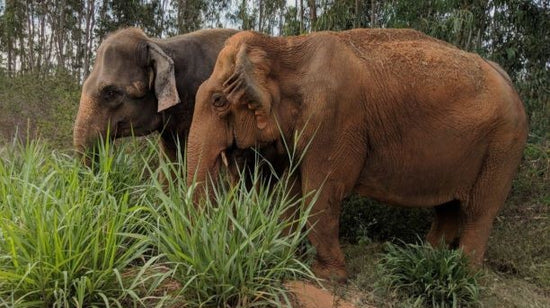
Work done so far
Work done so far
WRRC manages the first ever Elephant Care Facility in
Karnataka, situated at Lakshmisagar, Kolar; which provides a safe haven for
elephants in private custody that have faced decades of abuse and
maltreatment.It is home to Aneesha, a 52-year-old crippled elephant
who was injured by logging. Gowri, a 41-year-old elephant handed over by an
institution for treatment. and Durga, a 24 year old elephant handed over for
care by the Karnataka Forest Department. They also recently welcomed Janumani,
who was rescued from Goa.Your kind donations mean that the facility has a daily
supply of fresh grass, fruits, and vegetables, a full-time manager and mahouts,
to ensure that the elephants are well cared for. Regular health check-ups can
be carried out on both elephants and specialized elephant veterinarians visit
the centre.
Gallery
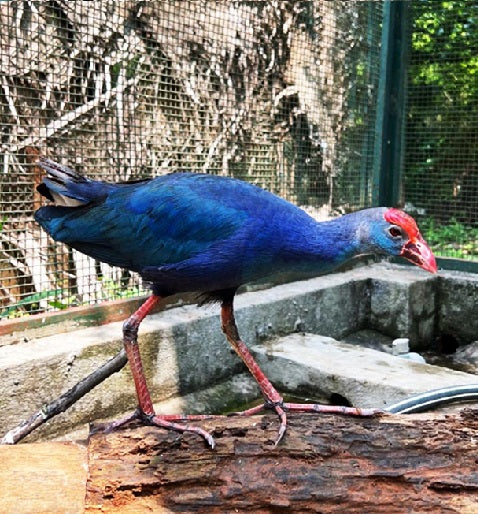
Grey Headed Swamphen
- The grey headed swamphen is endemic to the South Asian region but they have become common in America too. Juveniles are duller than adults and lack the red bill and shield. They usually inhabitant, in small groups, marshy areas and fresh water bodies such as swamps, rivers, and lakes. They clumsily feed on reeds and floating vegetation at muddy water edges.
- A young swamphen was brought to the centre from Jigni, on the outskirts of Bangalore. He was being kept as a pet captivity. Now he is active and healthy but will not be released soon as he is very comfortable with humans. This would pose a threat to his survival in the wild. BRC is in the process of rehabilitating and rewilding him. Once this happens, he will be released near a protected water body.

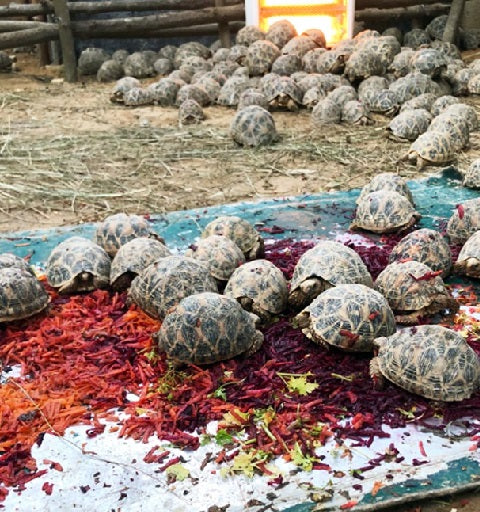
- They are native to India, Sri Lanka and Pakistan and are usually found in dry, scrub forests. The species is threatened by habitat loss and poaching for the illegal wildlife trade. They are herbivorous, mostly thriving on leaves and grasses in the wild.
- The Bangalore police in two separate incidents confiscated a total of 551 Star Tortoises from poachers and handed them over to us for rehabilitation and release into the wild. On arrival at the centre, they were examined by our veterinarian and the team. Some of them were isolated due to health issues and the others were housed in specially prepared enclosures equipped with diffused lighting and heating. Once they were cleared for release by our veterinarian, they were released in small batches inside the forests in the presence of officials from the Forest Department
Indian Star Tortoise
- They are native to India, Sri Lanka and Pakistan and are usually found in dry, scrub forests. The species is threatened by habitat loss and poaching for the illegal wildlife trade. They are herbivorous, mostly thriving on leaves and grasses in the wild.
- The Bangalore police in two separate incidents confiscated a total of 551 Star Tortoises from poachers and handed them over to us for rehabilitation and release into the wild. On arrival at the centre, they were examined by our veterinarian and the team. Some of them were isolated due to health issues and the others were housed in specially prepared enclosures equipped with diffused lighting and heating. Once they were cleared for release by our veterinarian, they were released in small batches inside the forests in the presence of officials from the Forest Department

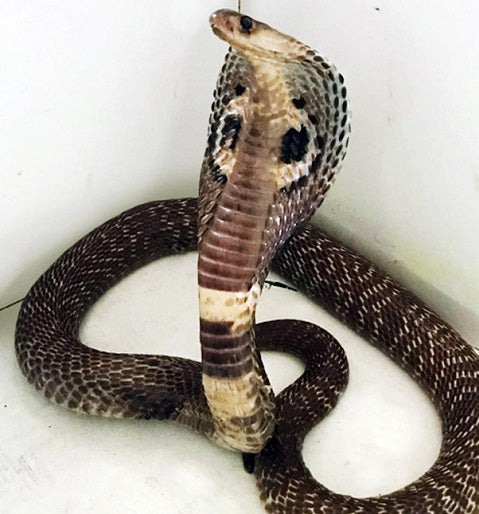
- Cobras are found from southern Africa through southern Asia to islands of Southeast Asia. They are highly venomous snakes, most of which expand the neck ribs to form a hood. The Indian Spectacled Cobra was formerly considered as a single species with the same distribution as the king cobra. However, biologists have recently discovered that about a dozen species exists in Asia, some being venom spitters and others not.
- WRRC received a case about a cobra, presumably a victim of a human-animal conflict situation. Due to the delay in discovering and rescuing the animal, the wounds were infected and maggot infested. A lot of effort was required to attend to the injuries and the chances of his survival seemed less but the staff did not give up hope and continued the treatment with utmost care. It's amazing to see how wildlife can overcome even the most harsh conditions. The snake made a full recovery and we will be releasing them in due course.
Cobra
- Cobras are found from southern Africa through southern Asia to islands of Southeast Asia. They are highly venomous snakes, most of which expand the neck ribs to form a hood. The Indian Spectacled Cobra was formerly considered as a single species with the same distribution as the king cobra. However, biologists have recently discovered that about a dozen species exists in Asia, some being venom spitters and others not.
- WRRC received a case about a cobra, presumably a victim of a human-animal conflict situation. Due to the delay in discovering and rescuing the animal, the wounds were infected and maggot infested. A lot of effort was required to attend to the injuries and the chances of his survival seemed less but the staff did not give up hope and continued the treatment with utmost care. It's amazing to see how wildlife can overcome even the most harsh conditions. The snake made a full recovery and we will be releasing them in due course.

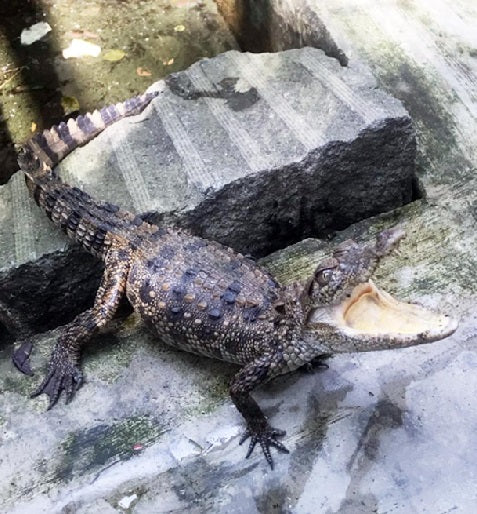
- Mugger Crocodile is native to freshwater habitats from the Indian subcontinent to southern Iran. Adults prey on fish, reptiles and mammals while the young feed on insects. The species has been listed as vulnerable on the IUCN Red List. They are threatened by human-wildlife conflict, get caught in fishing nets or killed in fear by humans.
- A young baby crocodile was rescued by the police and brought to the centre for rehabilitation. She was being kept in the sump of a house for sale into the illegal wildlife trade. The baby was very aggressive with a sharp set of teeth. She had to be carefully handled for examination and was left in an enclosure with a water pool filled with fish and frogs. Hiding and basking spaces were also provided which is essential for all captive reptiles. After an observation period of three weeks, the baby crocodile was released in a water body deep inside the protected forest.
Mugger Crocodile
- Mugger Crocodile is native to freshwater habitats from the Indian subcontinent to southern Iran. Adults prey on fish, reptiles and mammals while the young feed on insects. The species has been listed as vulnerable on the IUCN Red List. They are threatened by human-wildlife conflict, get caught in fishing nets or killed in fear by humans.
- A young baby crocodile was rescued by the police and brought to the centre for rehabilitation. She was being kept in the sump of a house for sale into the illegal wildlife trade. The baby was very aggressive with a sharp set of teeth. She had to be carefully handled for examination and was left in an enclosure with a water pool filled with fish and frogs. Hiding and basking spaces were also provided which is essential for all captive reptiles. After an observation period of three weeks, the baby crocodile was released in a water body deep inside the protected forest.

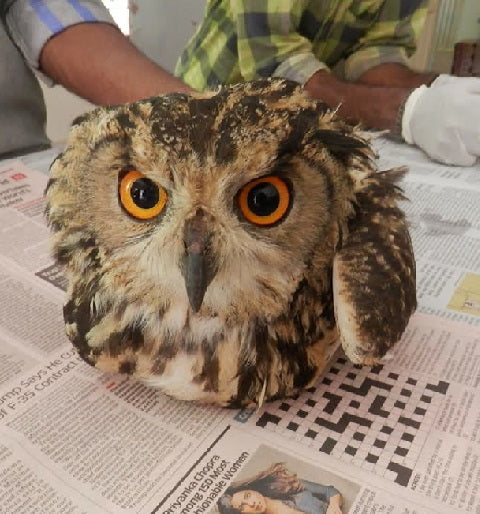
- Flying kites has always been considered to be a recreational activity and people enjoy it dearly. However, what most of us don’t know is the harm it causes the environment and the birds. The carelessly discarded manja often gets stuck on the tree branches or rooftops trapping unsuspecting birds who get severely injured by these glass coated threads.
- One such case is that of an owl who was brought to BRC. This young owl was tangled in the manja and her wings were deeply cut and infected leaving her severely dehydrated and disoriented. The team administered the required treatment. During the course of a few weeks her showed remarkable recovery and was soon released back into the wild.
Owl
- Flying kites has always been considered to be a recreational activity and people enjoy it dearly. However, what most of us don’t know is the harm it causes the environment and the birds. The carelessly discarded manja often gets stuck on the tree branches or rooftops trapping unsuspecting birds who get severely injured by these glass coated threads.
- One such case is that of an owl who was brought to BRC. This young owl was tangled in the manja and her wings were deeply cut and infected leaving her severely dehydrated and disoriented. The team administered the required treatment. During the course of a few weeks her showed remarkable recovery and was soon released back into the wild.

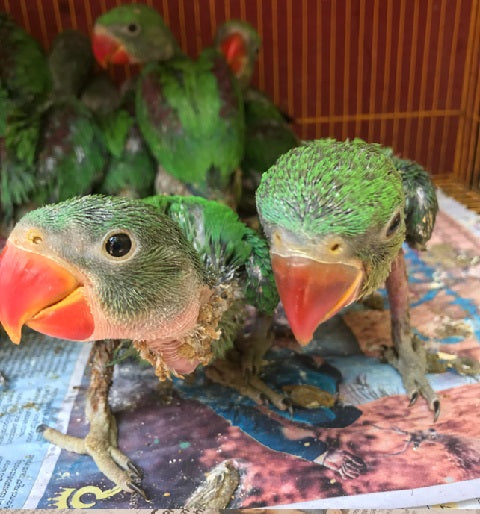
- The Alexandrine Parakeet lives in forests, woodlands, agricultural lands and mangrove forests. They feed on seeds, fruits and nuts. The Alexandrine Parakeet is listed as near threatened because of the steep population decline in their native range due to habitat loss, persecution and excessive capture to meet the demands of the illegal wildlife trade.
- On February, 26 baby Alexandrine Parakeets were rescued by the Bannerghatta Police Department and brought to the centre. After examination, they were divided into batches based on size.
- Vaccinations were completed in one month and as the temperature rose, they were all shifted to larger aviaries with platforms and branches that served as natural perches. A water bath was placed inside the enclosure for hydration. Here they got more space to move, exercise wings, practice flight, bathe in the water bath, groom themselves and bask in the spring sunlight. At night when temperature dropped, they would all huddle together to keep warm.
- In 6 months they should be ready to go back to the wild to live a life of complete freedom with no dependence on humans.
Parakeet
- The Alexandrine Parakeet lives in forests, woodlands, agricultural lands and mangrove forests. They feed on seeds, fruits and nuts. The Alexandrine Parakeet is listed as near threatened because of the steep population decline in their native range due to habitat loss, persecution and excessive capture to meet the demands of the illegal wildlife trade.
- On February, 26 baby Alexandrine Parakeets were rescued by the Bannerghatta Police Department and brought to the centre. After examination, they were divided into batches based on size.
- Vaccinations were completed in one month and as the temperature rose, they were all shifted to larger aviaries with platforms and branches that served as natural perches. A water bath was placed inside the enclosure for hydration. Here they got more space to move, exercise wings, practice flight, bathe in the water bath, groom themselves and bask in the spring sunlight. At night when temperature dropped, they would all huddle together to keep warm.
- In 6 months they should be ready to go back to the wild to live a life of complete freedom with no dependence on humans.

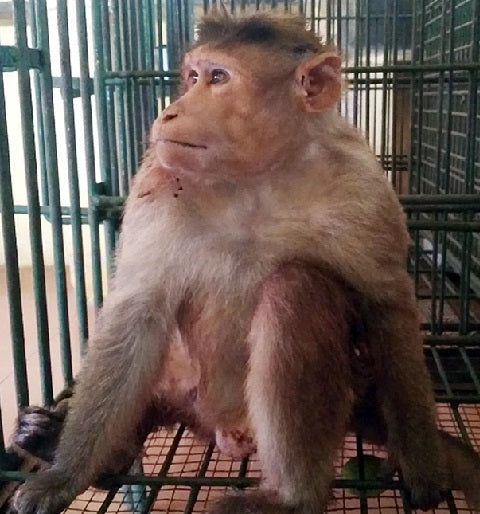
- Found in South India, the bonnet macaque feeds on fruits, nuts, seeds, flowers, invertebrates, and cereals. Being in proximity of human habitation this monkey sometimes raids gardens or stores for food, often resulting in conflicts with humans.
- This is a rescue story of a fearless male bonnet macaque who was found with a severe bite injuries from a vicious encounter with a domestic animal. He was stabilised and surgery was conducted to address all his injuries. He was strong and survived in spite of multiple injuries and copious blood loss. In a month all his injuries had healed perfectly and he was ready to go back home. Though spirited, we hope he has gained enough experience from his injuries not to confront and fight with any dog or cat even human beings for that matter.
Bonnet Macaque
- Found in South India, the bonnet macaque feeds on fruits, nuts, seeds, flowers, invertebrates, and cereals. Being in proximity of human habitation this monkey sometimes raids gardens or stores for food, often resulting in conflicts with humans.
- This is a rescue story of a fearless male bonnet macaque who was found with a severe bite injuries from a vicious encounter with a domestic animal. He was stabilised and surgery was conducted to address all his injuries. He was strong and survived in spite of multiple injuries and copious blood loss. In a month all his injuries had healed perfectly and he was ready to go back home. Though spirited, we hope he has gained enough experience from his injuries not to confront and fight with any dog or cat even human beings for that matter.

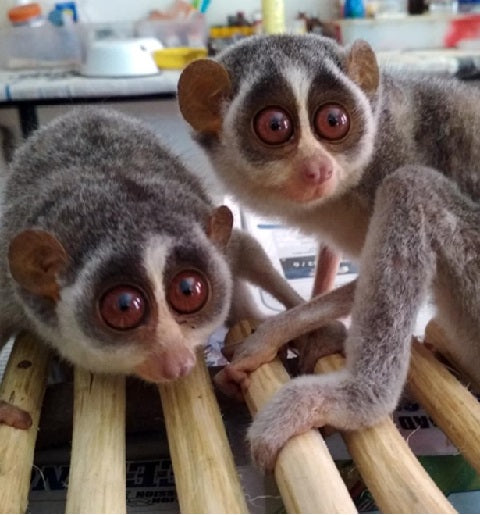
- Native to India and Sri Lanka, they are found in tropical rainforests, swamps, scrub and semi-deciduous forests. Slender lorises are arboreal, traveling along the treetops with slow and precise movements. They live up to 15 years and are mostly insectivorous and frugivorous.
- Slender Lorises are highly endangered due to indiscriminate poaching and superstitious beliefs that their body parts have medicinal or magical powers.
- Rescued by Bangalore Police, two male slender lorises were admitted to BRC. Traumatized and confused, they were initially under observation to rule out any internal injuries. Fortunately, they seemed to be healthy enough. Since slender lorises are nocturnal primates, we fed them insects and fruits in the night. After observation of two weeks, they were released inside a safe protected forest at night.
Slender Loris
- Native to India and Sri Lanka, they are found in tropical rainforests, swamps, scrub and semi-deciduous forests. Slender lorises are arboreal, traveling along the treetops with slow and precise movements. They live up to 15 years and are mostly insectivorous and frugivorous.
- Slender Lorises are highly endangered due to indiscriminate poaching and superstitious beliefs that their body parts have medicinal or magical powers.
- Rescued by Bangalore Police, two male slender lorises were admitted to BRC. Traumatized and confused, they were initially under observation to rule out any internal injuries. Fortunately, they seemed to be healthy enough. Since slender lorises are nocturnal primates, we fed them insects and fruits in the night. After observation of two weeks, they were released inside a safe protected forest at night.

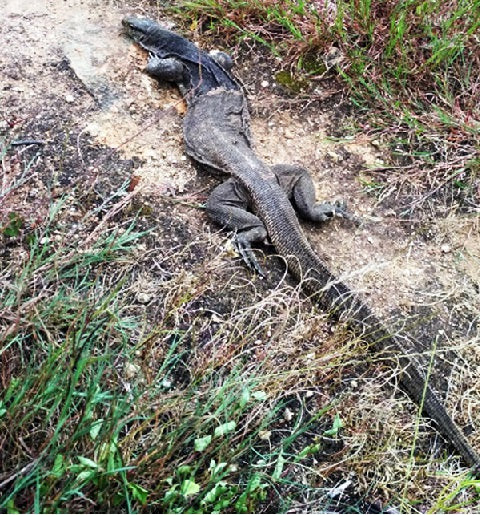
- These reptiles are caught from the forests of south India and used for their meat and fat; both of which are falsely believed to have aphrodisiacal and medicinal properties.
- In most cases, we find that their limbs are usually bound tightly together and their tail is thin, and devoid of any fat, indicating months of captivity and starvation. The limbs being tied for months causes the blood flow to be cut off and the extremity usually rots and falls off.
- An adult monitor lizard was rescued and brought to BRC for rehabilitation. This monitor was lucky as his limbs were not tied and tail was thick with fat deposits indicating that he was caught recently. After all the preliminary examination, treatment and observation were done to ascertain that he was healthy, the lizard was released in a safe, protected forest in the presence of Forest Department officials. It was so rewarding to see him scamper away at lightning speed.
Bengal Monitor Lizard
- These reptiles are caught from the forests of south India and used for their meat and fat; both of which are falsely believed to have aphrodisiacal and medicinal properties.
- In most cases, we find that their limbs are usually bound tightly together and their tail is thin, and devoid of any fat, indicating months of captivity and starvation. The limbs being tied for months causes the blood flow to be cut off and the extremity usually rots and falls off.
- An adult monitor lizard was rescued and brought to BRC for rehabilitation. This monitor was lucky as his limbs were not tied and tail was thick with fat deposits indicating that he was caught recently. After all the preliminary examination, treatment and observation were done to ascertain that he was healthy, the lizard was released in a safe, protected forest in the presence of Forest Department officials. It was so rewarding to see him scamper away at lightning speed.

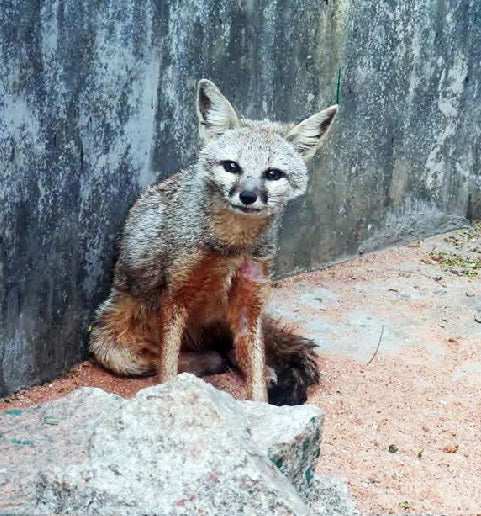
- Jackals are widespread across India and are omnivores, predators and scavengers.
- Most active at both dawn and dusk, they usually hunt either alone or in pairs. Sometimes they also gather in small packs to scavenge a carcass.
- A female jackal was rescued by the Forest Department officials and brought to BRC in January 2022. She was diagnosed with canine distemper (CD). Since there is no treatment for CD, we could only treat the illness caused by it and hoped for the best. But against all odds she recovered and is currently residing at the centre.
Jackal
- Jackals are widespread across India and are omnivores, predators and scavengers.
- Most active at both dawn and dusk, they usually hunt either alone or in pairs. Sometimes they also gather in small packs to scavenge a carcass.
- A female jackal was rescued by the Forest Department officials and brought to BRC in January 2022. She was diagnosed with canine distemper (CD). Since there is no treatment for CD, we could only treat the illness caused by it and hoped for the best. But against all odds she recovered and is currently residing at the centre.








